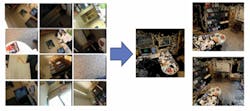Malware reconstructs 3-D scenes from stolen phone images
To study the potential ways in which the cameras in smart phones might be abused by criminals, an engineer at the Naval Surface Warfare Center (Crane, IN, USA) has developed a malware app which allows attackers to engage in remote reconnaissance and "virtual theft."
The so-called PlaceRaider malware -- which was created by Robert Templeton together with a team at Indiana University (Bloomington, IN, USA) -- can take control of the camera on an Android smartphone and capture images of its environment without a user's knowledge.
Once the images have been captured, they are then transferred from the phone to a server. To avoid having to transmit huge numbers of images to the servers, the PlaceRaider app analyzes the images for particularly promising content, removing redundant and uninformative images before transmitting the data. The server then takes the images, and reconstructs 3-D models from them.
Once the 3-D models have been created, Templeton has demonstrated how a remote attacker could use them to survey a phone user's home or work space and engage in virtual theft by viewing the contents of objects, including sensitive documents, personal photographs, and data on computer monitors.
Templeton and his colleagues detailed the development of the app in a recent paper. Entitled "PlaceRaider: Virtual Theft in Physical Spaces with Smartphones", the article describes the development of the app as well as the software techniques used to recreate 3-D models from the images captured by the phone.
It can be downloaded here.
Recent articles on smart phones that you might also be interested in reading.
1. Turn your iPhone into an IR camera
Engineer Andy Rawson decided to turn his iPhone into a thermal camera by developing custom-built hardware and software solution that would interface to it.
2. Smartphone system helps diagnose oral cancer
A Stanford University (Stanford, CA, USA) researcher has developed a way to use a smartphone to create detailed images of the oral cavity and screen patients’ mouths for suspicious lesions.
3. Student app helps farmers to measure quality of rice
A group of students from Bataan State Peninsula University (Bataan, Philippines) has developed a software “app” for a smart phone that can help farmers increase their chances of a good rice harvest.
-- Dave Wilson, Senior Editor, Vision Systems Design
